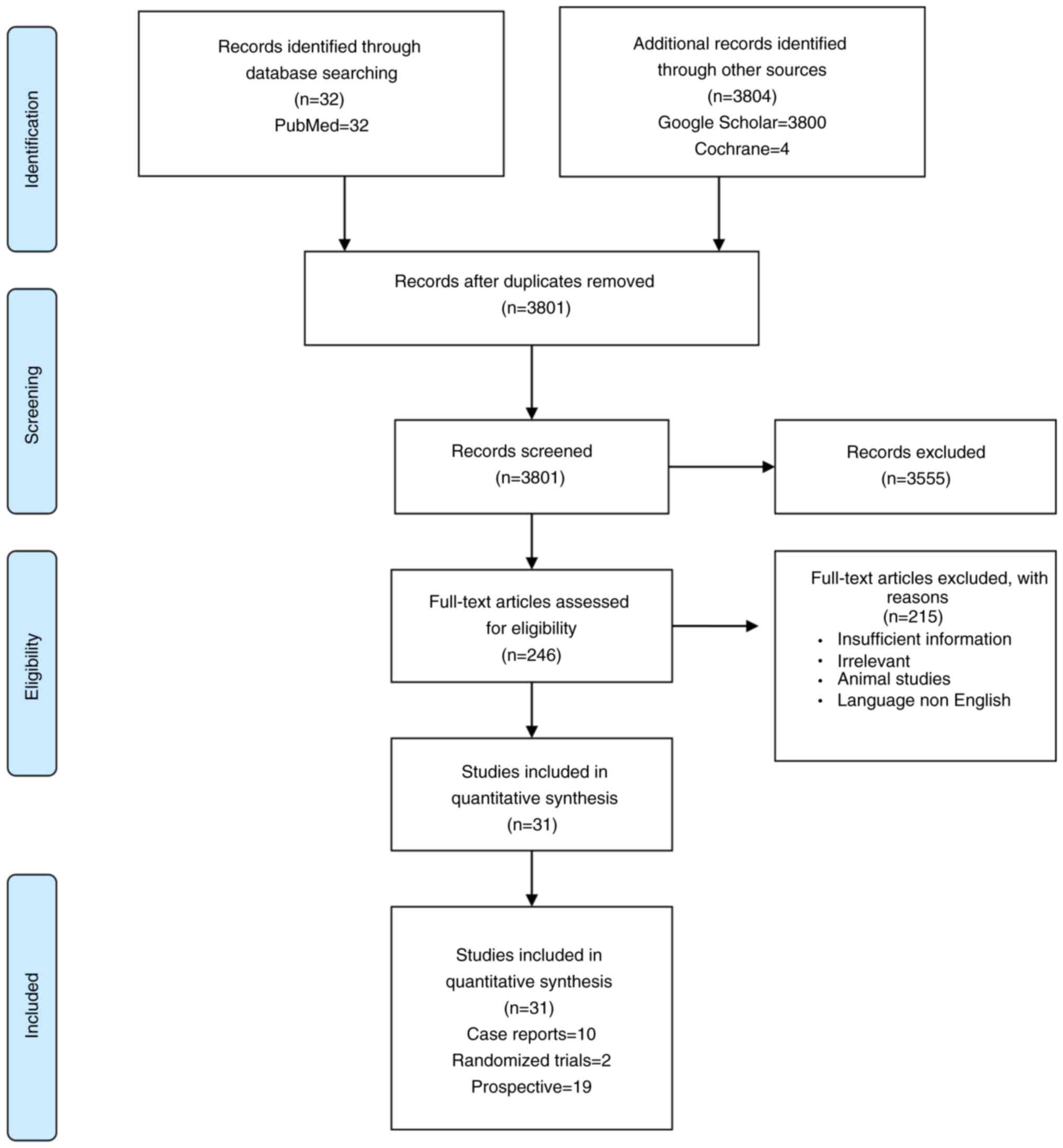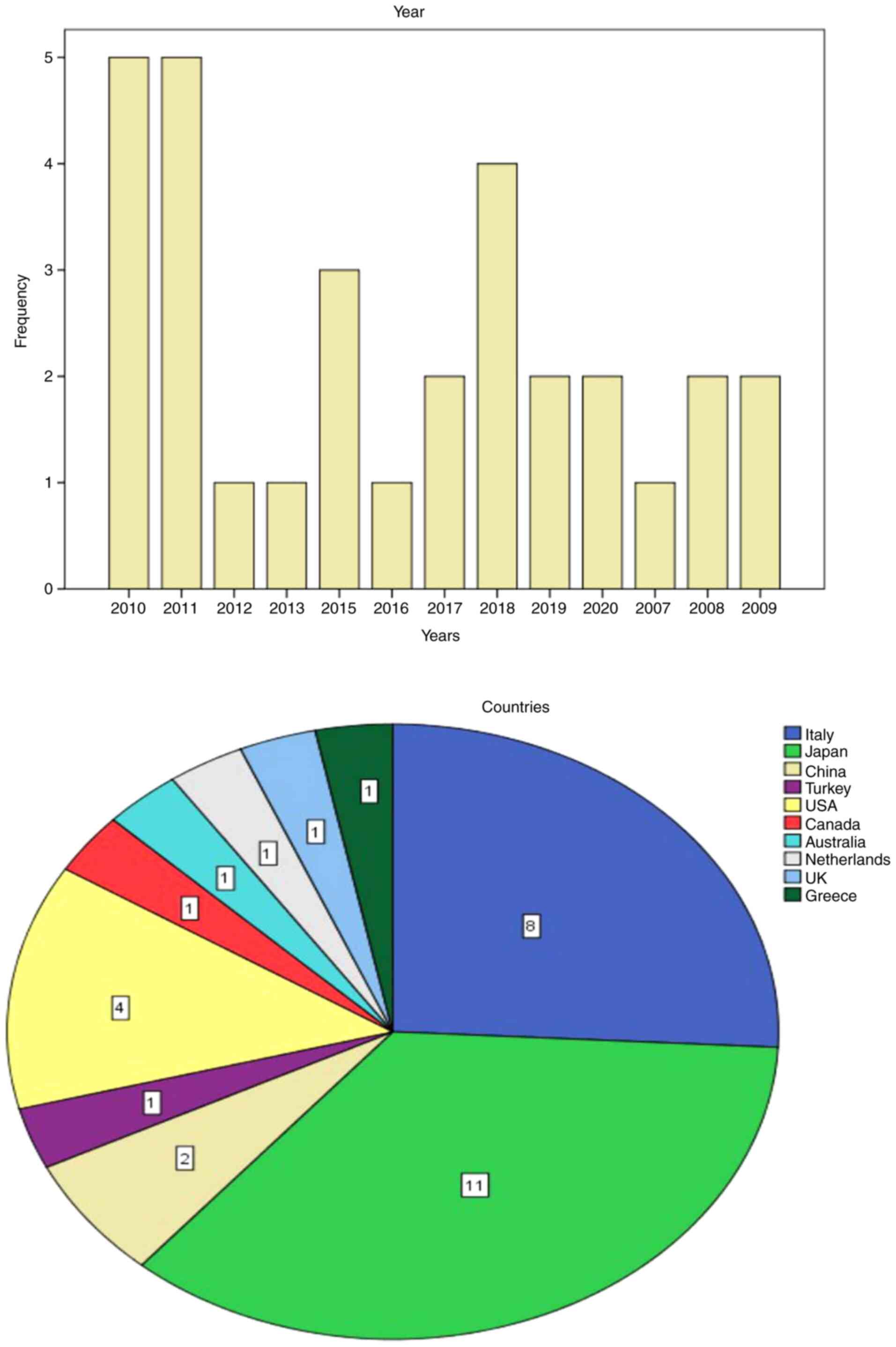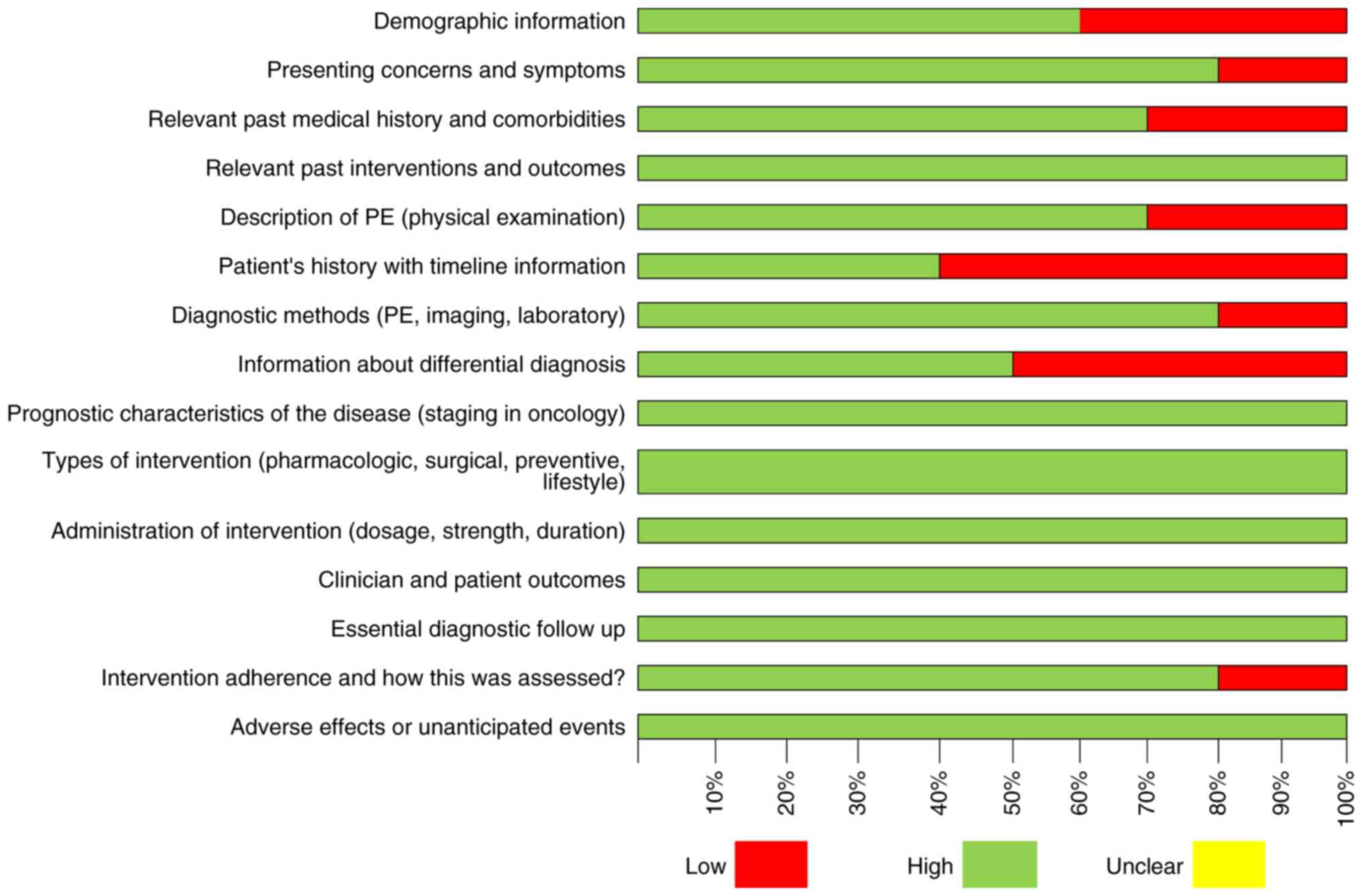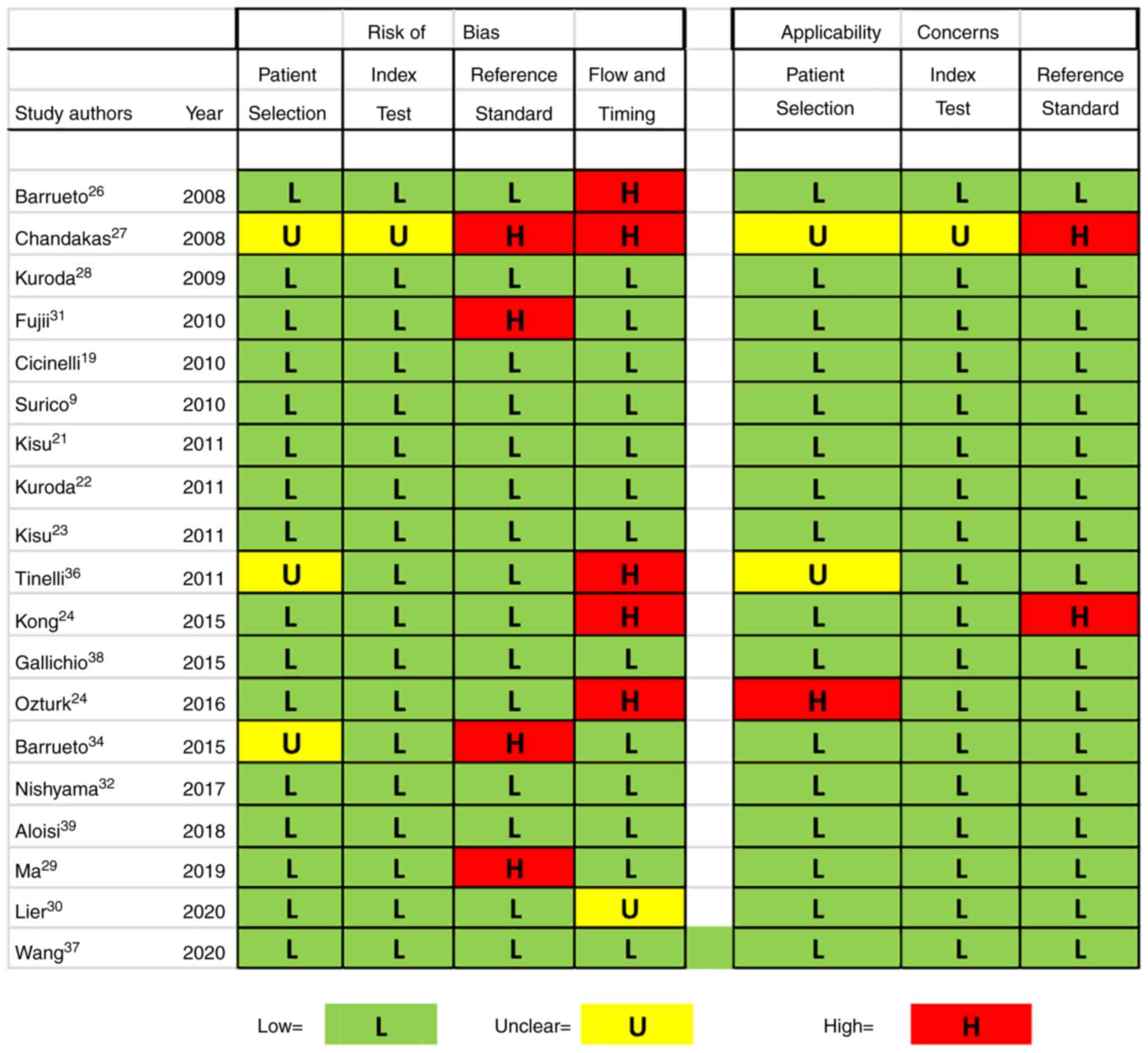|
1
|
Vincent BD and Fraig M: A pilot study of
narrow-band imaging compared to white light bronchoscopy for
evaluation of normal airways and premalignant and malignant airways
disease. Chest. 131:1794–1199. 2007.PubMed/NCBI View Article : Google Scholar
|
|
2
|
Sano Y and Horimatsu T: Magnifying
observation of microvascular architecture of colorectal lesions
using a narrow-band imaging system. Dig Endosc. 18:44–51. 2006.
|
|
3
|
Watanabe A and Taniguchi M: The value of
narrow band imaging endoscope for early head and neck cancers.
Otolaryngol Head Neck Surg. 138:446–451. 2008.PubMed/NCBI View Article : Google Scholar
|
|
4
|
Machida H, Sano Y, Hamamoto Y, Muto M,
Kozu T, Tajiri H and Yoshida S: Narrow-band imaging in the
diagnosis of colorectal mucosal lesions: A pilot study. Endoscopy.
36:1094–1098. 2004.PubMed/NCBI View Article : Google Scholar
|
|
5
|
Liberati A, Altman DG, Tetzlaff J, Mulrow
C, Gøtzsche PC, Ioannidis JP, Clarke M, Devereaux PJ, Kleijnen J
and Moher D: The PRISMA statement for reporting systematic reviews
and meta-analyses of studies that evaluate healthcare
interventions: Explanation and elaboration. BMJ.
339(b2700)2009.PubMed/NCBI View Article : Google Scholar
|
|
6
|
Whiting PF, Rutjes AW, Westwood ME,
Mallett S, Deeks JJ, Reitsma JB, Leeflang MM, Sterne JA and Bossuyt
PM: QUADAS-2 Group. QUADAS-2: A revised tool for the quality
assessment of diagnostic accuracy studies. Ann Intern Med.
155:529–536. 2011.PubMed/NCBI View Article : Google Scholar
|
|
7
|
Gagnier JJ, Kienle G, Altman DG, Moher D,
Sox H and Riley D: CARE Group. The CARE guidelines: Consensus-based
clinical case report guideline development. J Clin Epidemiol.
67:46–51. 2014.PubMed/NCBI View Article : Google Scholar
|
|
8
|
Tulandi T and Balayla J: Study designs and
the use of the canadian task force classification. J Obstet
Gynaecol Can. 40:1383–1384. 2018.PubMed/NCBI View Article : Google Scholar
|
|
9
|
Surico D, Vigone A and Leo L: Narrow band
imaging in endometrial lesions. J Minim Invasive Gynecol. 16:9–10.
2009.PubMed/NCBI View Article : Google Scholar
|
|
10
|
Raimondo I, Scarciglia ML, Amadio G,
Monterisi AF, Scambia G and Masciullo V: Narrow band imaging: А new
diagnostic tool in adenomyosis? Int J Gynaecol Obstet.
119:S531–S867. 2012.PubMed/NCBI View Article : Google Scholar
|
|
11
|
Farrugia M, Nair MS and Kotronis KV:
Narrow band imaging in endometriosis. J Minim Invasive Gynecol.
14:393–394. 2007.PubMed/NCBI View Article : Google Scholar
|
|
12
|
Murnaghan O, Rajakumar C, Bougie O and
Singh SS: Use of narrowband imaging for the surgical management of
endometriosis. J Obstet Gynaecol Can. 39(711)2017.PubMed/NCBI View Article : Google Scholar
|
|
13
|
Kazama S, Hiramatsu T, Kuroda K, Hongo K,
Watanabe Y, Tanaka T and Kuriki K: A case of unique endoscopic
findings of intestinal endometriosis exposed to the mucosa:
Aggregation of papillary protruded bulges from the submucosal
elevation of the rectum. Clin J Gastroenterol. 12:166–170.
2019.PubMed/NCBI View Article : Google Scholar
|
|
14
|
Anko M, Nakamura M, Kobayashi Y, Tsuji K,
Nakada S, Nakamura Y, Funakoshi T, Banno K and Aoki D: Primary
malignant melanoma of the uterine cervix or vagina which were
successfully treated with nivolumab. J Obstet Gynaecol Res.
46:190–195. 2020.PubMed/NCBI View Article : Google Scholar
|
|
15
|
Fanfani F, Gallotta V, Rossitto C, Fagotti
A and Scambia G: Narrow band imaging in borderline ovarian tumor. J
Minim Invasive Gynecol. 17:146–147. 2010.PubMed/NCBI View Article : Google Scholar
|
|
16
|
Fanfani F, Rossito C, Faggotti A, Gallotta
V, Gagliardi ML and Scambia G: Narrow-band imaging in laparoscopic
management of cervical carcinoma. J Minim Invasive Gynecol.
18:146–147. 2011.PubMed/NCBI View Article : Google Scholar
|
|
17
|
Gagliardi ML, Polito S, Fagotti A, Fanfani
F and Scambia G: Narrow-band imaging in laparoscopic management of
recurrent platinum sensitive ovarian cancer. J Minim Invasive
Gynecol. 20:10–12. 2013.PubMed/NCBI View Article : Google Scholar
|
|
18
|
Kobara H, Uchita K, Uedo N, Matsuura N,
Nishiyama N, Kanenishi K and Masaki T: Uterine cervical neoplasm
diagnosed by flexible magnifying endoscopy with narrow band
imaging. Diagnostics (Basel). 10(903)2020.PubMed/NCBI View Article : Google Scholar
|
|
19
|
Cicinelli E, Tinelli R, Colafiglio G,
Pastore A, Mastrolia S, Lepera A and Clevin L: Reliability of
narrow-band imaging (NBI) hysteroscopy: A comparative study. Fertil
Steril. 94:2303–2307. 2010.PubMed/NCBI View Article : Google Scholar
|
|
20
|
Surico D, Vigone A, Bonvini D, Tinelli R,
Leo L and Surico N: Narrow-band imaging in diagnosis of endometrial
cancer and hyperplasia: A new option? J Minim Invasive Gynecol.
17:620–625. 2010.PubMed/NCBI View Article : Google Scholar
|
|
21
|
Kisu I, Banno K, Kobayashi Y, Ono A,
Masuda K, Ueki A, Nomura H, Hirasawa A, Abe T, Kouyama K, et al:
Flexible hysteroscopy with narrow band imaging (NBI) for endoscopic
diagnosis of malignant endometrial lesions. Int J Oncol.
38:613–618. 2011.PubMed/NCBI View Article : Google Scholar
|
|
22
|
Kuroda K, Kitade M, Kikuchi I, Kumakiri J,
Matsuoka S, Tokita S, Kuroda M and Takeda S: A new instrument: A
flexible hysteroscope with narrow band imaging system: Optical
quality comparison between a flexible and a rigid hysteroscope.
Minim Invasive Ther Allied Technol. 20:263–266. 2011.PubMed/NCBI View Article : Google Scholar
|
|
23
|
Kisu I, Banno K, Susumu N and Aoki D:
Magnifying hysteroscopy with narrow-band imaging for visualization
of endometrial lesions. Int J Gynaecol Obstet. 115(1):74–5.
2011.PubMed/NCBI View Article : Google Scholar
|
|
24
|
Kong L, Duan H, Zhang Y, Wang Y and Guo Y:
Application of narrow-band imaging in the diagnosis of endometrial
lesions. J Minim Invasive Gynecol. 22(S45)2015.PubMed/NCBI View Article : Google Scholar
|
|
25
|
Ozturk M, Ulubay M, Alanbay I, Keskin U,
Karasahin E and Yenen MC: Using narrow-band imaging with
conventional hysteroscopy increases the detection of chronic
endometritis in abnormal uterine bleeding and postmenopausal
bleeding. J Obstet Gynaecol Res. 42:67–71. 2016.PubMed/NCBI View Article : Google Scholar
|
|
26
|
Barrueto FF and Audlin KM: The use of
narrowband imaging for identification of endometriosis. J Minim
Invasive Gynecol. 15:636–639. 2008.PubMed/NCBI View Article : Google Scholar
|
|
27
|
Chandakas S, Salamalekis E and Erian J:
New narrow band imaging endoscopic system for the detectionof
surface pathology including endometriosis: A series of 95 patients.
J Minim Invasive Gynecol. 15:S1–S159. 2008.
|
|
28
|
Kuroda K, Kitade M, Kikuchi I, Kumakiri J,
Matsuoka S, Jinushi M, Shirai Y, Kuroda M and Takeda S: Vascular
density of peritoneal endometriosis using narrow-band imaging
system and vascular analysis software. J Minim Invasive Gynecol.
16:618–621. 2009.PubMed/NCBI View Article : Google Scholar
|
|
29
|
Ma T, Chowdary P, Eskander A, Ellett L,
McIlwaine K, Manwaring J, Readman E and Maher P: Can narrowband
imaging improve the laparoscopic identification of superficial
endometriosis? A prospective cohort trial. J Minim Invasive
Gynecol. 26:427–433. 2019.PubMed/NCBI View Article : Google Scholar
|
|
30
|
Lier MC, Vlek SL, Ankersmit M, van de Ven
PM, Dekker JJML, Bleeker MCG, Mijatovic V and Tuynman JB:
Comparison of enhanced laparoscopic imaging techniques in
endometriosis surgery: A diagnostic accuracy study. Surg Endosc.
34:96–104. 2020.PubMed/NCBI View Article : Google Scholar
|
|
31
|
Fujii T, Nakamura M, Kameyama K, Saito M,
Nishio H, Ohno A, Hirao N, Iwata T, Tsukazaki K and Aoki D: Digital
colposcopy for the diagnosis of cervical adenocarcinoma using a
narrow band imaging system. Int J Gynecol Cancer. 20:605–610.
2010.PubMed/NCBI View Article : Google Scholar
|
|
32
|
Nishiyama N, Kanenishi K, Mori H, Kobara
H, Fujihara S, Chiyo T, Kobayashi N, Matsunaga T, Ayaki M, Yachida
T, et al: Flexible magnifying endoscopy with narrow band imaging
for the diagnosis of uterine cervical tumors: A cooperative study
among gastrointestinal endoscopists and gynecologists to explore a
novel microvascular classification system. Oncol Lett. 14:355–362.
2017.PubMed/NCBI View Article : Google Scholar
|
|
33
|
Kuroda K, Kitade M, Kikuchi I, Kumakiri J,
Matsuoka S, Kuroda M and Takeda S: Peritoneal vascular density
assessment using narrow-band imaging and vascular analysis
software, and cytokine analysis in women with and without
endometriosis. J Minim Invasive Gynecol. 17:21–25. 2010.PubMed/NCBI View Article : Google Scholar
|
|
34
|
Barrueto FF, Audlin KM, Gallicchio L,
Miller C, MacDonald R, Alonsozana E, Johnston M and Helzlsouer KJ:
Sensitivity of narrow band imaging compared with white light
imaging for the detection of endometriosis. J Minim Invasive
Gynecol. 22:846–852. 2015.PubMed/NCBI View Article : Google Scholar
|
|
35
|
Uchita K, Kanenishi K, Hirano K, Kobara H,
Nishiyama N, Kawada A, Fujihara S, Ibuki E, Haba R, Takahashi Y, et
al: Characteristic findings of high-grade cervical intraepithelial
neoplasia or more on magnifying endoscopy with narrow band imaging.
Int J Clin Oncol. 23:707–714. 2018.PubMed/NCBI View Article : Google Scholar
|
|
36
|
Tinelli R, Surico D, Leo L, Pinto V,
Surico N, Fusco A, Cicinelli MV, Meir YJ and Cicinelli E: Accuracy
and efficacy of narrow-band imaging versus white light hysteroscopy
for the diagnosis of endometrial cancer and hyperplasia: a
multicenter controlled study. Menopause. 18:1026–1029.
2011.PubMed/NCBI View Article : Google Scholar
|
|
37
|
Wang W, Chen F, Kong L, Guo Y, Cheng J and
Zhang Y: Prospective evaluation of the accuracy of a training
program in image recognition by narrow-band imaging guided
hysteroscopy of endometrial neoplasms. Gynecol Obstet Invest.
85:284–289. 2020.PubMed/NCBI View Article : Google Scholar
|
|
38
|
Gallicchio L, Helzlsouer KJ, Audlin KM,
Miller C, MacDonald R, Johnston M and Barrueto FF: Change in pain
and quality of life among women enrolled in a trial examining the
use of narrow band imaging during laparoscopic surgery for
suspected endometriosis. J Minim Invasive Gynecol. 22:1208–1214.
2015.PubMed/NCBI View Article : Google Scholar
|
|
39
|
Aloisi A, Sonoda Y, Gardner GJ, Park KJ,
Elliott SL, Zhou QC, Iasonos A and Abu-Rustum NR: Prospective
comparative study of laparoscopic narrow band imaging (NBI) versus
standard imaging in gynecologic oncology. Ann Surg Oncol.
25:984–990. 2018.PubMed/NCBI View Article : Google Scholar
|
|
40
|
Wright VC: Cervical glandular disease:
Adenocarcinoma in situ and adenocarcinoma. In: Colposcopy
Principles and Practice. Barbara S, Apgar GL and Spitzer M (eds).
2nd edition. Saunders Elsevier, Philadelphia, PA, 283Y310,
2008.
|
|
41
|
Carugno J, Di Spiezio Sardo A, Alonso L,
Haimovich S, Campo R, De Angelis C, Bradley L, Bettocchi S, Arias
A, Isaacson K, et al: COVID-19 pandemic. Impact on hysteroscopic
procedures: A consensus statement from the global congress of
hysteroscopy scientific committee. J Minim Invasive Gynecol.
27:988–992. 2020.PubMed/NCBI View Article : Google Scholar
|
|
42
|
Thomas V, Maillard C, Barnard A, Snyman L,
Chrysostomou A, Shimange-Matsose L and Van Herendael B:
International Society for Gynecologic Endoscopy (ISGE) guidelines
and recommendations on gynecological endoscopy during the
evolutionary phases of the SARS-CoV-2 pandemic. Eur J Obstet
Gynecol Reprod Biol. 253:133–140. 2020.PubMed/NCBI View Article : Google Scholar
|
|
43
|
American Association of Gynecologic
Laparoscopists. COVID-19: Joint Society Statement on Elective
Surgery. Available from: http://www.aagl.org/news/covid-19-joint-statement-on-elective-surgeries/.
|
|
44
|
Kisu I, Banno K, Tsuji K, Masuda K, Ueki
A, Kobayashi Y, Yamagami W, Susumu N and Aoki D: Narrow band
imaging in gynecology: A new diagnostic approach with improved
visual identification (Review). Int J Oncol. 40:350–356.
2012.PubMed/NCBI View Article : Google Scholar
|
|
45
|
Schnelldorfer T, Jenkins RL, Birkett DH,
Wright VJ, Price LL and Georgakoudi I: Laparoscopic narrow band
imaging for detection of occult cancer metastases: A randomized
feasibility trial. Surg Endosc. 30:1656–1661. 2016.PubMed/NCBI View Article : Google Scholar
|
|
46
|
Hirst A, Philippou Y, Blazeby J, Campbell
B, Campbell M, Feinberg J, Rovers M, Blencowe N, Pennell C, Quinn
T, et al: No Surgical innovation without evaluation: Evolution and
further development of the IDEAL framework and recommendations. Ann
Surg. 269:211–220. 2019.PubMed/NCBI View Article : Google Scholar
|


















